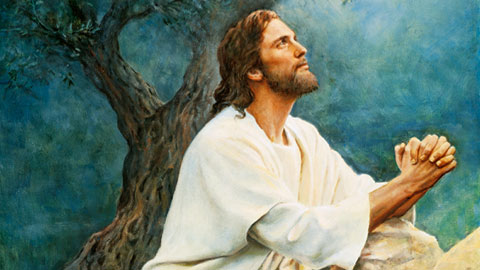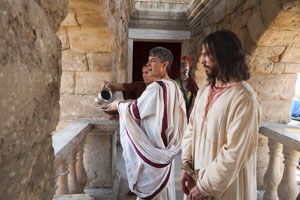 Our Lord and Savior, Jesus Christ, was born to be “lifted up.” That is, He was born to die on the cross at Golgotha. His death was foretold both in the Bible and in the Book of Mormon. His was the great and final, infinite and eternal, sacrifice, accepted by God as the offering for our sins. His atonement not only guaranteed us immortality in the resurrection, but freedom of punishment for our sins, if we would only follow Him and repent in His name.
Our Lord and Savior, Jesus Christ, was born to be “lifted up.” That is, He was born to die on the cross at Golgotha. His death was foretold both in the Bible and in the Book of Mormon. His was the great and final, infinite and eternal, sacrifice, accepted by God as the offering for our sins. His atonement not only guaranteed us immortality in the resurrection, but freedom of punishment for our sins, if we would only follow Him and repent in His name.
Matthew 26:47–75; Mark 14:43–72; Luke 22:47–71; John 18:1–27; Matthew 27:1–26; Mark 15:1–15; Luke 23:1–25; John 18:28–19:16; Matthew 27:27–66; Mark 15:16–39; Luke 23:26–56; John 19:17–42.
See also—Isaiah 53; Mark 15:39–47; John 3:16; 15:13; 1 Nephi 11:32–33; 19:7–9; 2 Nephi 9:21–22.
Jesus is Betrayed
 Christ had barely ended His agony in the Garden of Gethsemane, but He was betrayed by Judas Iscariot. Judas is wholly guilty of this betrayal, in that he willfully rebelled. Some have surmised that he just wanted Jesus to have an audience with the Sanhedrin, but the Bible says otherwise. Judas may have lost faith in Jesus, when He did not become the David-warrior many Jews were expecting in their Messiah, but it is certain that Judas is a “Son of Perdition.”
Christ had barely ended His agony in the Garden of Gethsemane, but He was betrayed by Judas Iscariot. Judas is wholly guilty of this betrayal, in that he willfully rebelled. Some have surmised that he just wanted Jesus to have an audience with the Sanhedrin, but the Bible says otherwise. Judas may have lost faith in Jesus, when He did not become the David-warrior many Jews were expecting in their Messiah, but it is certain that Judas is a “Son of Perdition.”
Although Christ had foretold His own death on many occasions, His apostles seemed not to fully understand the great and last sacrifice Jesus would have to make. Things became very dangerous for them the second Christ was betrayed, and they essentially scattered and remained in disarray, not knowing what to do next, until Christ rose and returned to teach them. During Christ’s punishment and crucifixion, they were basically terrorized onlookers, without the ability to control or influence events.
The Giver of the Law, the Subject of the Law
 Remember that the pre-mortal Christ was Jehovah, or YHWH, son of Elohim. He was the God of the Old Testament, and it was He who dictated the Law of Moses on Sinai. The Law of Moses covered every aspect of life—religious belief and practice, health, property rights, family affairs, and even the justice system of the Israelites. The Law of Moses was broken again and again in order to send Jehovah Himself to torture and death.
Remember that the pre-mortal Christ was Jehovah, or YHWH, son of Elohim. He was the God of the Old Testament, and it was He who dictated the Law of Moses on Sinai. The Law of Moses covered every aspect of life—religious belief and practice, health, property rights, family affairs, and even the justice system of the Israelites. The Law of Moses was broken again and again in order to send Jehovah Himself to torture and death.
The Sanhedrin, the ruling legal body of the Jews, comprising seventy members and a high priest (a position that was at that time corruptly purchased from the Romans), met in Jerusalem. (There were lower courts for the Jews throughout Judea and Israel.) They only tried high cases. Christ was taken to them, and then to Roman authorities, Pontius Pilate (governor of Jerusalem) and Herod (who presided over Galilee). These jurisdictions were decided upon because Jesus was a Jew, a subject of Rome, and a Galilean.
The charge against Him in the Jewish court was blasphemy. The charge in the Roman courts was treason. The Sanhedrin could not pronounce the death penalty. This ability had been proscribed by their Roman overseers.
The Sanhedrin broke many of the Laws of Moses in order to condemn Christ.
- No part of Jewish legal proceedings could take place at night; Jesus was arrested and tried at night.
- The High Priest (then Caiaphas, or his father-in-law Annas) was forbidden to privately interview the accused. The accused was always to be provided a “friend in court.”
- Christ had no one to defend Him.
- The Sanhedrin was not allowed to originate charges. They tried to find accusers, but the witnesses had to agree with each other.
- The trial and execution infringed upon Passover and the Feast of Unleavened Bread.
- No sentence of death was allowed to be passed without an extra day to consider the innocence or guilt of the accused. Jesus’ entire trial lasted less than 24 hours.
- The Sanhedrin were not allowed to make a unanimous ruling. This may sound odd, but it protected the accused. We don’t know if the entire Sanhedrin was present (both Pharisees and Sadducees were members of the group), or whether only enemies of Christ were bidden during the night, which would have been an even worse travesty.
- No one was allowed to accuse Himself, so a man could not be found guilty by his own confession. This law protected the accused from torture to extract a confession. Someone must be a second witness to the crime of a confession by the accused.
- Jesus remained silent, so He could not incriminate Himself. He knew exactly what the Sanhedrin were doing. He allowed them to seal their own eternal fate.
- The Sanhedrin began with the charge of sedition, before settling on blasphemy. It was up to them to research the charges and bring witnesses for both sides.
- Since the Sanhedrin were not allowed to execute a prisoner, they trumped up a charge of treason to present to Pilate, who found no guilt in Jesus.
- By taking Jesus to Pilate (governor of Judea), the Sanhedrin left their own court, which by their own law, should have negated the trial. Their court was legally confined to the Hall of Hewn Stones.
- Judges were forced to recuse themselves if they were related to the accused, or if they were enemies of the accused. These judges were out to kill Jesus because they hated Him and were jealous of His power to attract followers. They should have recused themselves and bowed out of the trial.
- The Mosaic Law provides all sorts of ways for the accused to prove his innocence. None of these were accorded to Jesus. He never was allowed any defense.
- The high priest, head of the Sanhedrin, was not allowed to make any sort of physical or oral statement that he considered the accused to be guilty, but in this case, the high priest slapped Jesus, cried out, and tore his robes.
The whole trial of Christ was illegal. His arrest was illegal on the grounds that no proof was offered of any offense. He was also arrested without a warrant and was mistreated during the arrest. The trial was at night. Night trials were contrary to their own laws. Instead of seeking the truth, they sought false witnesses. They had Him condemned in their own minds before He was arrested. (Read more…)
Jesus was scourged and mocked, a crown of thorns pressed upon His head, His clothes bid upon by unknowing Roman soldiers. He was forced to carry His cross along the streets of Jerusalem. He was crucified at Golgotha.
The Crucifixion
 Jesus was crucified on Thursday afternoon, just as Passover began, as the sacrificial lambs were being slain in the temple. Josephus tells us that in 70 AD (when the Romans laid siege upon Jerusalem and destroyed it) there were 250,000 lambs sacrificed in the temple, meaning about 2,500,000 Jews were in Jerusalem for the festival. Thus, Jesus was crucified at the time of great gathering. There were huge crowds in and about the city at the time. Jesus’ trial and execution were carried out in the midst of this teeming, but festive time.
Jesus was crucified on Thursday afternoon, just as Passover began, as the sacrificial lambs were being slain in the temple. Josephus tells us that in 70 AD (when the Romans laid siege upon Jerusalem and destroyed it) there were 250,000 lambs sacrificed in the temple, meaning about 2,500,000 Jews were in Jerusalem for the festival. Thus, Jesus was crucified at the time of great gathering. There were huge crowds in and about the city at the time. Jesus’ trial and execution were carried out in the midst of this teeming, but festive time.
Were there any who were so preoccupied that they were unknowing regarding these events? It’s unlikely. Jesus was famous for His miracles. He was front page news all three years of His ministry. God gives us opportunities to make our decisions and follow through with our intentions, thus condemning or exonerating ourselves. This said, to condemn all Jews for the crucifixion of Christ is a huge, terrible mistake, one that has been committed often throughout history. The wicked Jewish leaders had their cronies in the crowd, shouting “Crucify Him! Crucify Him!” They were in charge from beginning to end. Even those who loved and believed in Jesus were caught in a tidal wave of events they could not stop— a tidal wave God meant to move forward.
Probably the most difficult moments of Jesus’ life were those upon the cross when His Father withdrew. This was the last test for Christ in order for Him to descend below all things, so He could then succor us. He suffered for our sins and sorrows, but He had yet never felt bereft of God’s presence. He had to experience that, too.
Next: Book of Mormon Events at the Crucifixion of Christ
Additional Resources:
The Lord Jesus Christ in Mormonism
